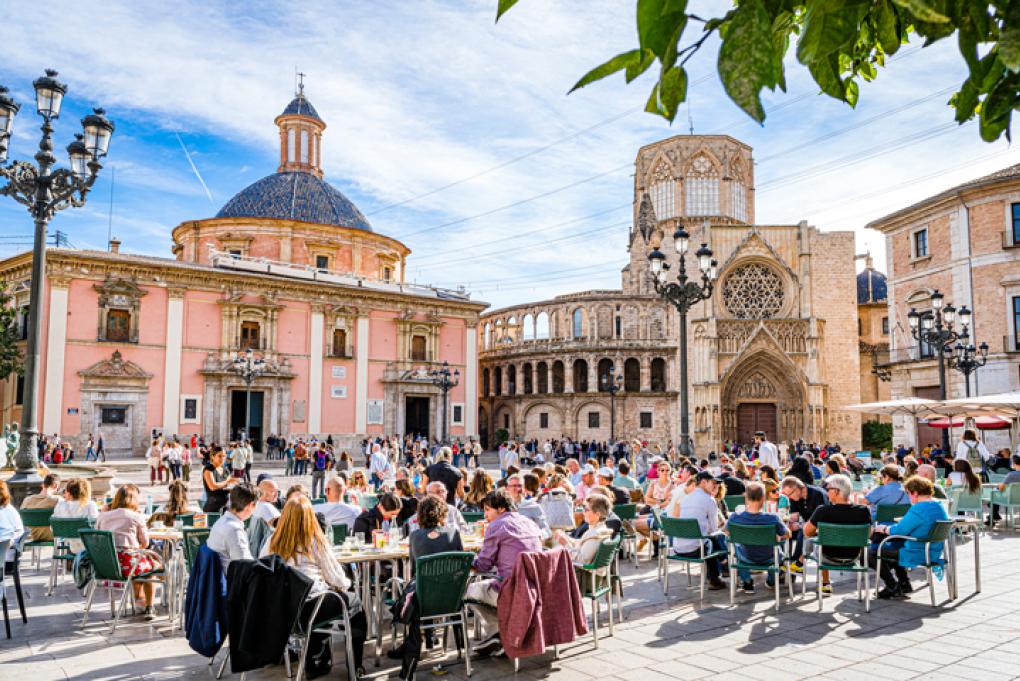
How has the slump in foreign tourism affected the residential property market?
The Spanish residential market has suffered from a slump in foreign demand during the pandemic. Restrictions on international travel have hit the most tourist-oriented areas of the Mediterranean coast and islands particularly hard, which have seen a sharp fall in purchases by foreigners. Nevertheless, although house prices in these tourist-oriented municipalities have seen a marked slowdown, the adjustment was very moderate until Q1 2021 and the outlook for the coming quarters is good, thanks to the revival of international tourism, especially in the coming year.
Foreign demand for housing has suffered during the pandemic
There is no doubt that the pandemic severely affected the property market on the Mediterranean coast and islands throughout 2020 and the first few months of 2021. The slump in international tourism due to restrictions on travel and uncertainty regarding how the health and economic situation would develop have led to a significant decline in the number of foreigners buying residential properties in Spain, plummeting by almost 50% year-on-year in Q2 2020. Although purchases began to recover in the second half of last year, they could not avoid ending the year with a sharp fall of 24.2%, almost 10 pp more than the decline recorded in purchases by Spaniards (–15.6%), which were not so severely affected by restrictions on travel within the country.
Purchases by foreigners
fell by 24% in 2020, accounting for 11.3% of the total.
The restrictions on international travel in place in Q1 2021 continued to weigh heavily on foreign demand, which still posted significant declines in year-on-year terms (–17.8%) while domestic purchases were starting to recover slightly (4.1% year-on-year, –0.7% with respect to Q1 2019). As a result, the share of foreign purchases out of all sales fell below 10% in Q1 2021 (to 9.7%), something not seen since 2013.
Nevertheless, in spite of this slump in foreign demand, the numbers of transactions have remained strong: foreigners bought around 47,500 homes in Spain in 2020 (11.3% of all sales), a figure similar to that of 2015 and much higher than the average for 2008-2014 (28,000 homes per year), suggesting their interest in acquiring a residence in our country has not diminished.
One factor that has helped to sustain international purchases during the pandemic has been the digitisation of the marketing and financing for new developments. Developers that had already invested in adopting new digital technologies have been able to continue offering their services remotely, for example through virtual tours of properties. Financial institutions have also improved the range of digital products and services for their non-resident customers, offering the possibility of opening an account or applying for a mortgage 100% online, among other facilities.
Foreign demand for housing is recovering more slowly than domestic demand
Number of house purchases per quarter

Uneven impact depending on the buyer’s nationality
The overall trend in purchases by foreigners is a sharp fall in 2020 and a certain recovery in 2021, but both the size of the decline and the speed of the recovery are quite different depending on the buyer’s country of origin.
Among the major markets for Spain, British purchases fell the most sharply in 2020 (–29.1%), not only because of the strong impact of the pandemic in the UK but possibly also because of Brexit. Nevertheless, this was still the nationality that bought the most homes in Spain in 2020 (around 6,200, 13% of all foreign purchases) and purchases are recovering at a similar speed to the other two major buyers, the French and Germans, a recovery which is relatively slow (the chart shows the German bubble below the 45-degree straight line marked in red dots). The Netherlands is in a similar position, with its purchases falling slightly but a slower recovery.
On the other hand, Norway, China and Ukraine recorded the largest declines in 2020 and showed no signs of recovery in Q1 2021. However, this is not a worrying statistic as the relative weight of these three nationalities combined only accounts for 6.3% of the total, as indicated by the size of the bubble in the chart. Finally, Morocco, Belgium and Sweden show a positive trend, posting a limited decline in 2020 and a rapid recovery in Q1 2021. In particular, Morocco stands out as the only nationality with a year-on-year growth (9.2%) in purchases in Q1 2021.
Purchases by foreigners: an uneven recovery across nationalities
Year-on-year change in Q1 2021 (%)

Waiting for foreign demand
Looking to the future, the prospects for recovery are encouraging, as suggested by the number of Google searches on buying a home in Spain carried out from other countries. In May, coinciding with the start of the easing of restrictions on international travel, there was a strong recovery in the intention to buy on the part of foreigners, especially in France, Belgium, the Netherlands and Norway. In contrast, searches from the UK and Italy remain depressed, with Germany, Sweden and Denmark somewhere in the middle. It is expected that the progress of the vaccination campaign in European countries and the implementation of the EU’s COVID digital certificate will boost the pent-up demand from foreigners, who are waiting until they can travel to buy a home in Spain.15 In addition, new work patterns accelerated by the pandemic, such as teleworking, will allow European workers to stay in Spain for longer periods of time to enjoy the Mediterranean climate while working remotely, so the market now has a new profile of international buyer.
- 15For an analysis of the reasons why foreigners tend to buy a home in Spain, see the article «The rise in house purchases by foreigners in Spain» at https://www.caixabankresearch.com/en/sector-analysis/real-estate/rise-house-purchases-foreigners-spain
Monthly Google searches related to buying a home in Spain
Percentage of purchases by each nationality out of the total number of purchases by foreigners

Searches about buying a home in Spain
are on the rise among the main residential property buyers for our country, with the notable exception of the British.
The Mediterranean coast and islands have been hit the hardest
As we pointed out at the beginning, the slump in foreign demand has hit the real estate market particularly hard on the Mediterranean coast and islands, locations which accounted for 85% of foreign purchases in 2019. There were sharp falls across all the provinces in the region albeit with some differences in terms of intensity: in Girona the decline was relatively more moderate (–18.5%) while Cadiz posted the largest fall (–35.6%), as can be seen in the chart. Alicante, the province with by far the largest number of property purchases by foreigners (24% of the national total), posted a decline of 30% in 2020. Nevertheless, more than 10,000 transactions were completed in 2020 (37% of all purchases in the province, compared to 41% in 2019).
The islands and Mediterranean coastline concentrate foreign housing demand

The figures by province encompass very different local real estate markets in terms of the distribution of foreign nationals. For instance, looking again at the province of Alicante, the share of tourists for Benidorm is very different to that of Alcoy and the potential impact of the slump in international tourism on either locality is therefore also necessarily different. However, at a municipal level, the official data on residential property purchases do not distinguish the origin of the buyers, which is why we have used internal CaixaBank data in order to assess the impact of tourism on such purchases by municipality. By analysing the percentage of CaixaBank POS terminal spending using foreign cards, we have been able to classify municipalities into tourist and non-tourist.16 The following chart shows the trend in purchases for all municipalities according to this classification (in terms of number and year-on-year change). In 2020, the drop in purchases in tourist municipalities was much sharper than in non-tourist municipalities (–17.8% compared to –12.4%) while, in the first few months of 2021, the recovery was weaker in tourist municipalities. Returning to our previous example, in Benidorm, where foreign card spending accounted for 33% of the total in 2019 compared to 1% in Alcoy, property purchases fell by 37.3% in 2020 compared to an increase of 7.1% in Alcoy.
- 16Specifically, if spending with foreign cards via CaixaBank POS terminals accounted for more than 10% of the total in 2019, we classify this location as a tourist municipality.
The impact on house prices has been more contained
In 2020, house prices slowed down across the board throughout Spain, although the loss of dynamism was greater in tourist municipalities. Specifically, the average price in tourist-oriented municipalities went from 7.5% growth in 2019 to a decline of 1.1% in 2020. The slowdown in non-tourist municipalities was also notable, albeit less intense: the average house price went from 7.1% growth in 2019 to 1.6% in 2020 (still positive).
The effects of the pandemic on international tourism therefore had more of an impact on residential property prices in the most tourist-oriented localities. Returning once again to the municipalities of Alicante, we can see that house prices in Benidorm went from 7.0% growth in 2019 to a decline of 3.1% in 2020. In contrast, house prices in Alcoy accelerated from 3.0% growth in 2019 to 4.5% in 2020.
House prices have slowed markedly
in tourist areas but are showing some resistance to falling and the outlook is good.
Looking ahead, the projected house prices at a municipal level, obtained from the machine learning models of CaixaBank’s real estate big data tool,17 show a slight upward trend for the coming year. In particular, the model predicts an average house price increase of 0.5% in tourist municipalities and a slightly higher increase of 0.9% in non-tourist municipalities. These forecasts, although positive, are more moderate than those provided by the model before the pandemic, when growth of around 2% per year was projected.
- 17This tool combines millions of internal CaixaBank data with reliable external sources of data. This enables the application of machine learning algorithms, which improve the forecasts as more information is available. The Ministry of Transport, Mobility and Urban Agenda’s historical series of house prices has been used to train the models, based on free housing appraisals.
A promising outlook for foreign housing demand
In short, after an atypical 2020, the outlook for 2021 in terms of foreign demand and prices in tourist areas is positive, although the speed of recovery will depend on how quickly international tourism revives and the excellent communications are restored that existed before the pandemic with Spain’s main source countries for inbound tourism. In 2022 we expect international tourism to get back to normal and connections to be re-established, so it is very likely the boom in foreign demand for residential properties will be even greater than before COVID-19.18 Spain continues to be hugely attractive due to many different factors, such as climate, quality of life, safety, health and culture, and to all this we must add a new type of international buyer who can now do their work remotely, thanks to the flexibility offered by teleworking.
- 18However, it should be remembered that Spain has rivals in the Mediterranean, not only in terms of the tourists they attract but also the number of foreigners buying a home there.




